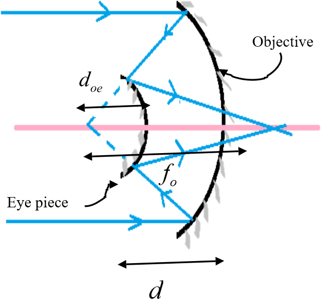
Concept explainers
The distance from the eyepiece of a reflecting telescope, where the electronic sensor can be placed to record the image of the star.
Answer to Problem 38P
Solution:
The electronic sensor must be placed at a distance of 3 m from the eyepiece of the telescope.
Explanation of Solution
Cassegrain telescope is a kind of astronomical telescope where a concave mirror is used as objective and a convex mirror as its eye piece. Parallel rays from the distant star is allowed to fall on the objective mirror and the image of the star is formed at the focus of the concave mirror. This image serves as a virtual object for the convex mirror and the mirror forms its real image. If the electronic sensor is placed at the point where the image is formed, the image of the star can be recorded.
The arrangement is as shown below.

The focal lengths of the objective and the eyepiece are related to their respective radii of curvature and as follows.
The image of the star after reflection from the objective is formed at the focus of the mirror. If the mirrors are placed at a distance from each other, then the object distance for the convex mirror is given by,
The mirror equation is then used to calculate the distance of the image from the convex mirror.
The sensor is to be placed at a distance from the eyepiece mirror.
Given:
The radius of curvature of objective mirror
The radius of curvature of the eyepiece mirror
The distance between the mirrors
Formula:
Calculation:
Using the given values of the radii of curvature and calculate the focal lengths of the objective and the eyepiece mirrors.
Calculate the distance at which the virtual object is located behind the convex eyepiece mirror.
Use the mirror formula for the eye piece to calculate the image distance. Since the object is located at the same side as the focus of the mirror, according to the sign conventions, both carry the same sign.
Therefore, the image is formed at a distance from the eyepiece mirror.
Chapter 25 Solutions
Physics: Principles with Applications
Additional Science Textbook Solutions
Modern Physics
Sears And Zemansky's University Physics With Modern Physics
Physics for Scientists and Engineers: A Strategic Approach with Modern Physics (4th Edition)
College Physics
Conceptual Physics (12th Edition)
Tutorials in Introductory Physics
 College PhysicsPhysicsISBN:9781305952300Author:Raymond A. Serway, Chris VuillePublisher:Cengage Learning
College PhysicsPhysicsISBN:9781305952300Author:Raymond A. Serway, Chris VuillePublisher:Cengage Learning University Physics (14th Edition)PhysicsISBN:9780133969290Author:Hugh D. Young, Roger A. FreedmanPublisher:PEARSON
University Physics (14th Edition)PhysicsISBN:9780133969290Author:Hugh D. Young, Roger A. FreedmanPublisher:PEARSON Introduction To Quantum MechanicsPhysicsISBN:9781107189638Author:Griffiths, David J., Schroeter, Darrell F.Publisher:Cambridge University Press
Introduction To Quantum MechanicsPhysicsISBN:9781107189638Author:Griffiths, David J., Schroeter, Darrell F.Publisher:Cambridge University Press Physics for Scientists and EngineersPhysicsISBN:9781337553278Author:Raymond A. Serway, John W. JewettPublisher:Cengage Learning
Physics for Scientists and EngineersPhysicsISBN:9781337553278Author:Raymond A. Serway, John W. JewettPublisher:Cengage Learning Lecture- Tutorials for Introductory AstronomyPhysicsISBN:9780321820464Author:Edward E. Prather, Tim P. Slater, Jeff P. Adams, Gina BrissendenPublisher:Addison-Wesley
Lecture- Tutorials for Introductory AstronomyPhysicsISBN:9780321820464Author:Edward E. Prather, Tim P. Slater, Jeff P. Adams, Gina BrissendenPublisher:Addison-Wesley College Physics: A Strategic Approach (4th Editio...PhysicsISBN:9780134609034Author:Randall D. Knight (Professor Emeritus), Brian Jones, Stuart FieldPublisher:PEARSON
College Physics: A Strategic Approach (4th Editio...PhysicsISBN:9780134609034Author:Randall D. Knight (Professor Emeritus), Brian Jones, Stuart FieldPublisher:PEARSON





